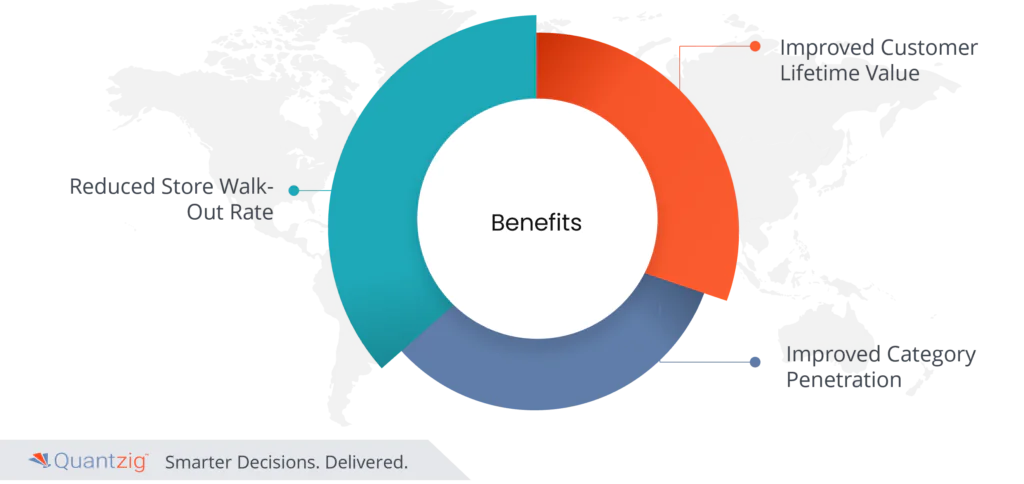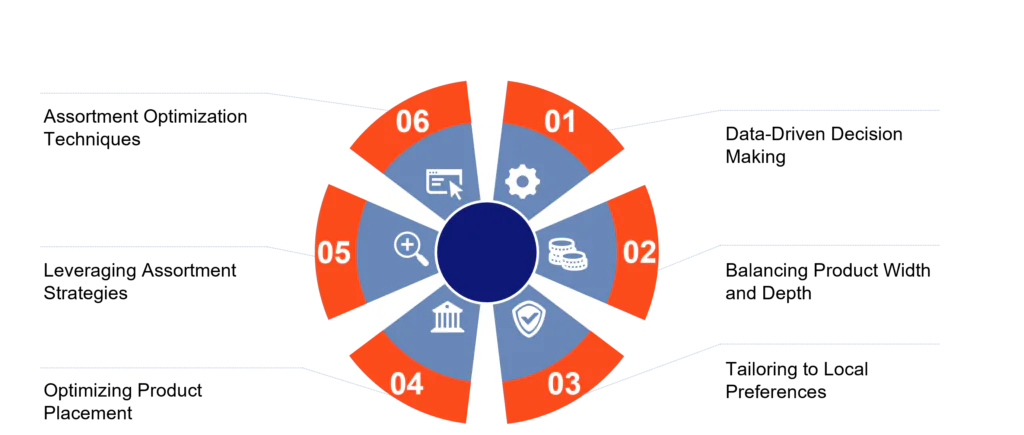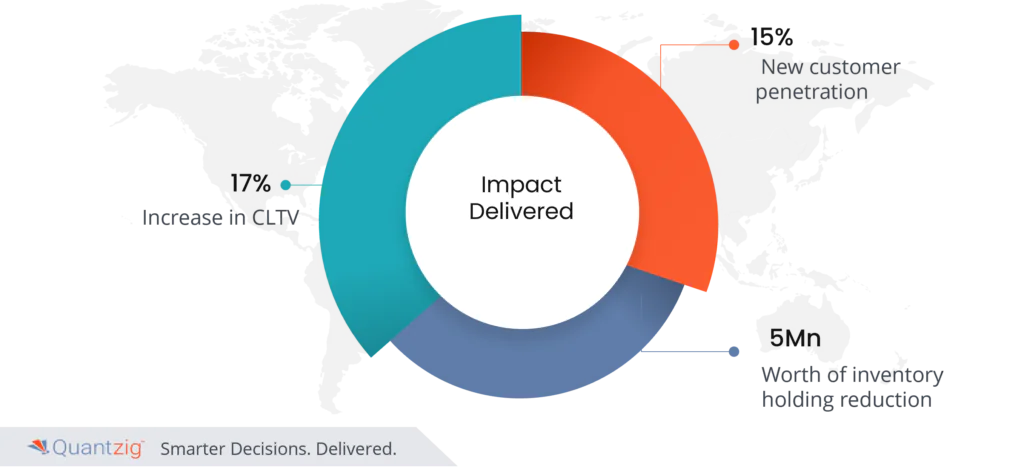Author: Associate Vice President, Analytics and Data Strategy, Quantzig.
Table of Contents
Table of Contents
- Introduction
- What is Retail Assortment Optimization?
- Factors that Influence Retailers’ Assortment Decisions
- Benefits of Retail Assortment Optimization
- Potential Disadvantages of Retail Assortment Strategies
- What are the Strategies of Retail Assortment Optimization?
- Quantzig’s Retail Assortment Optimization Solution
- Conclusion
Introduction to Retail Assortment Optimization
As consumers’ preferences and behaviors continue to shift at an unprecedented pace, retailers face a daunting challenge: how to curate product assortments that resonate with their target audiences, maximize profitability, and stay ahead of the competition. In this era of data-driven decision-making and technological advancements, the future of assortment optimization promises a tantalizing blend of challenges and innovations.
This article explores the complexities of this retail landscape, examining the pressing challenges confronting retailers and revealing the cutting-edge innovations set to redefine how businesses tailor their offerings to a discerning and diverse customer base. Join us on this insightful journey as we uncover the strategies and solutions shaping the future of retail assortment optimization, equipping retailers with the knowledge and tools needed to thrive in an ever-evolving marketplace.
Book a demo to experience the meaningful insights we derive from data through our analytical tools and platform capabilities. Schedule a demo today!
Request a Free DemoWhat is Retail Assortment Optimization?
Retail assortment optimization is the process of selecting and arranging products in a retail store to maximize sales and customer satisfaction. It involves analyzing consumer preferences, market trends, and sales data to determine which products to stock, where to place them, and how to promote them effectively. This approach aims to create a balanced and profitable product mix that meets customer needs and drives business growth.
What Factors Influence Retailers’ Assortment Decisions?

Factors Influencing Retailers’ Assortment Decisions:
1. Customer Preferences and Behavior:
- Understanding customer needs, shopping habits, and preferences for product assortment, quality, pricing, and services.
- Analyzing factors like convenience, product variety, quality, pricing, and excitement/experience.
2. Competition:
- Monitoring competition from retailers using the same format (intra-type competition) as well as those using different formats (inter-type competition).
- Accounting for the impact of “scrambled merchandising” where retailers expand into new product categories.
3. Environmental Trends:
- Adapting to changing customer needs, demographic shifts, technological advancements, economic conditions, and evolving legal/regulatory framework.
4. Data and Analytics:
- Relying on accurate, real-time data on sales, market insights, and consumer trends to make informed assortment decisions.
- Overcoming challenges like data silos, lack of collaboration, and outdated information.
Top Benefits of Assortment Optimization in the Retail Sector
Assortment optimization plays a pivotal role in the retail sector for several compelling reasons, each contributing to the overall success and profitability of a retail business.

1. Reduced Store Walk-Out Rate:
- One of the primary benefits of assortment optimization is its ability to reduce the store walk-out rate. When retailers offer a well-curated and tailored assortment of products, it enhances the shopping experience by ensuring that customers can easily find what they are looking for.
- This, in turn, minimizes frustration and increases the likelihood of customers leaving the store empty-handed or dissatisfied. By optimizing assortments to meet the specific demands of their target audience, retailers can effectively engage customers, increase in-store dwell time, and ultimately boost sales.
2. Improved Customer Lifetime Value:
- Assortment optimization also contributes significantly to improving customer lifetime value. By consistently offering products that align with the preferences and needs of their customer base, retailers can foster customer loyalty.
- Satisfied customers are more likely to make repeat purchases, become brand advocates, and remain loyal over the long term. This not only increases revenue but also reduces customer acquisition costs, as retaining existing customers is often more cost-effective than acquiring new ones.
3. Improved Category Penetration:
- Effective assortment optimization enables retailers to delve deeper into category penetration. By analyzing sales data, market trends, and customer insights, retailers can identify opportunities to expand their product offerings within specific categories.
- This allows retailers to capture a larger share of their customers’ spending within those categories, further increasing sales and profitability.
Assortment optimization is not just a strategic choice; it’s a necessity in the highly competitive retail landscape. It enhances the shopping experience, drives customer loyalty, and maximizes revenue potential, making it an indispensable tool for retailers looking to thrive in today’s market.
Experience the advantages firsthand by testing a customized complimentary pilot designed to address your specific requirements. Pilot studies are non-committal in nature.
Request a Free PilotPotential Disadvantages of Retail Assortment Strategies
| Potential Disadvantage | Description |
|---|---|
| 1. Overstocking and Understocking | Inaccurate demand forecasting leads to overstocking or understocking of products, resulting in inventory holding costs, markdowns, or stockouts. |
| 2. Inefficient Use of Retail Space | Poor product assortment planning leads to inefficient use of retail space, with underperforming products taking up valuable floor space. |
| 3. Customer Dissatisfaction | Offering products that do not meet customer needs or preferences leads to customer dissatisfaction, negative reviews, and reduced loyalty. |
| 4. Increased Complexity | Implementing and managing complex assortment strategies adds to the operational complexity of the retail business. |
| 5. Limited Flexibility | Rigid assortment strategies limit the retailer’s ability to respond quickly to changing market trends, customer preferences, or competitor actions. |
| 6. Higher Costs | Implementing advanced analytics and technology to support assortment strategies can be costly. |
| 7. Dependence on Data Quality | The accuracy and reliability of data used to inform assortment decisions are crucial. Poor data quality can lead to incorrect decisions. |
| 8. Lack of Customer Insights | Insufficient understanding of customer preferences and behaviors can result in assortment decisions that do not align with customer needs. |
| 9. Inadequate Training | Insufficient training for retail staff on assortment strategies and product knowledge can lead to poor execution and customer dissatisfaction. |
| 10. Compliance and Regulatory Issues | Retailers must ensure that their assortment strategies comply with relevant regulations, which can add complexity and costs. |
What are the Accurate Strategies of Retail Assortment Optimization?


Here are the key strategies for effective retail assortment optimization:
1. Data-Driven Decision Making
- Leverage historical sales data, customer segmentation, and market trends to identify patterns and optimize assortments
- Analyze factors like basket composition, top-selling categories, and seasonal demand to inform product selection
2. Balancing Product Width and Depth
- Determine the optimal mix of product lines (width) and variety within each line (depth) based on store size, resources, and customer preferences
- Specialty stores tend to focus on depth while mass retailers prioritize width
3. Tailoring to Local Preferences
- Customize assortments based on the characteristics of the geographical region and demographics to cater to local demand
- For example, clothing retailers offering different inventory in different climates
4. Optimizing Product Placement
- Strategically place complementary and related products together to encourage impulse purchases and upselling
- Position popular items with less popular ones to drive sales across the assortment
5. Leveraging Assortment Strategies
- Employ tactics like wide assortment (broad product lines with less depth), deep assortment (focused categories with extensive options), scrambled assortment (expanding beyond core offerings), and localized assortment (tailoring to local preferences)
6. Assortment Optimization Techniques
- Use advanced analytics and predictive modeling to select the optimal set of products that maximizes revenue based on customer preferences and constraints like shelf space and inventory costs
The key is striking the right balance between data-driven insights, strategic planning, and agility to respond to evolving market conditions. By applying these strategies, retailers can develop assortments that resonate with target customers, drive sales growth, and optimize inventory investment.
Quantzig’s Assortment Optimization Solution for a Leading US-Based Retail Company
| Aspect | Details |
|---|---|
| Client | Leading retail company located in USA |
| Challenges | 1. High footfall not converting into sales 2. Declining revenue per square foot 3. High carry-over volume of unsold merchandise to the next cycle |
| Solutions by Quantzig | Consumer Choice-Based Assortment Optimization Model: Aligned product offerings with customer preferences, leading to higher conversion rates and increased revenue. SKU Rationalization Model: Identified underperforming SKUs and optimized space allocation, improving sales per square foot. Assortment Allocation and Target Planning Tool: Improved inventory and promotion management, reducing unsold merchandise carry-over. |
| Impact Delivered | 17% increase in CLTV (Customer Lifetime Value) 15% new customer penetration $5 million worth of inventory holding reduction |
Client Details
A leading retail company located in USA.
Retail assortment optimization challenges faced by the Client
The client was confronted with several pressing challenges within their retail business:
1. Footfall not Converting into Sales:
The first challenge revolved around a high footfall in their stores but a low conversion rate into actual sales. While attracting customers to the store is crucial, the inability to convert foot traffic into transactions reflects inefficiencies in various aspects such as store layout, merchandising, staff engagement, or pricing strategies.
2. Declining Revenue per Sq. Ft:
Another critical challenge was the declining revenue per square foot of retail space. A decrease in revenue per sq. ft suggests that the store is underperforming and failing to optimize its use of valuable retail space. Factors contributing to this decline may include ineffective product assortments, inefficient space allocation, or a lack of engagement strategies to maximize customer spending.
3. High Carry-over Volume to the Next Cycle:
The third challenge pertained to high carry-over volumes of unsold merchandise from one sales cycle to the next. This not only ties up capital in unsold inventory but also indicates a mismatch between supply and demand. It could result from inaccurate demand forecasting, poor inventory management, or ineffective promotion strategies, ultimately impacting the client’s profitability and cash flow.
Retail assortment optimization Solutions offered by Quantzig
Quantzig, through its innovative solutions, provided invaluable assistance to the client in tackling the multifaceted challenges they faced in the retail sector:
1. Consumer Choice-Based Assortment Optimization Model:
- Quantzig leveraged advanced analytics and market research to develop a consumer choice-based assortment optimization model. This solution allowed the client to align their product offerings more closely with customer preferences and shopping behaviors.
- By tailoring their assortments to meet specific customer demands, the company witnessed a significant increase in conversion rates as foot traffic translated into higher sales, thereby enhancing overall revenue.
2. SKU Rationalization Model:
- To address the issue of declining revenue per square foot, our team implemented an SKU rationalization model. This approach helped the client optimize their product assortment by identifying underperforming SKUs and reallocating retail space to high-demand items.
- As a result, they experienced improved space utilization, increased sales per square foot, and a more efficient use of their retail floor.
3. Assortment Allocation and Target Planning Tool:
- We also introduced an assortment allocation and target planning tool that enabled the client to better manage their inventory and promotions.
- This tool helped reduce carry-over volumes of unsold merchandise by accurately forecasting demand, aligning assortments with regional preferences, and optimizing promotional activities, ultimately leading to improved inventory turnover and enhanced profitability.
Impact Delivered from Quantzig’s retail assortment optimization solution

- 17% increase in CLTV
- 15% new customer penetration
- 5Mn worth of inventory holding reduction.
Get started with your complimentary trial today and delve into our platform without any obligations. Explore our wide range of customized, consumption driven analytical solutions services built across the analytical maturity levels.
Start your Free TrialConclusion
The future of assortment optimization in the retail sector is shaped by challenges and innovations that demand a strategic approach. As retailers navigate evolving omnichannel market trends, the integration of analytics tools will be crucial in refining assortment planning and leveraging assortment models. Optimizing inventory to align with consumer preferences and enhancing cross-merchandising efforts will drive profitability. The rise of e-commerce platforms necessitates adaptive products and sales strategies to meet diverse market demands. Embracing these innovations, retailers can achieve superior assortment strategies, ensuring future growth and customer satisfaction in a data-driven world.



